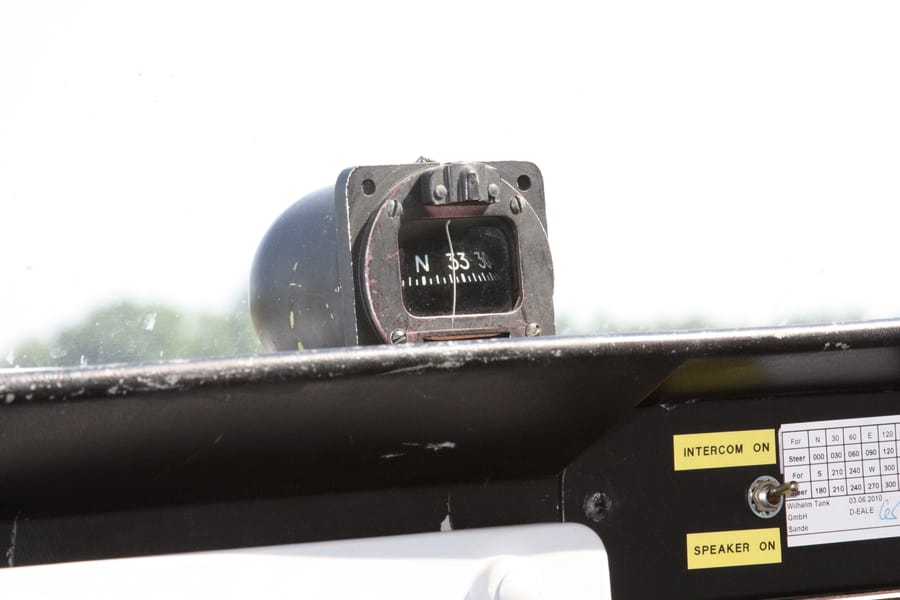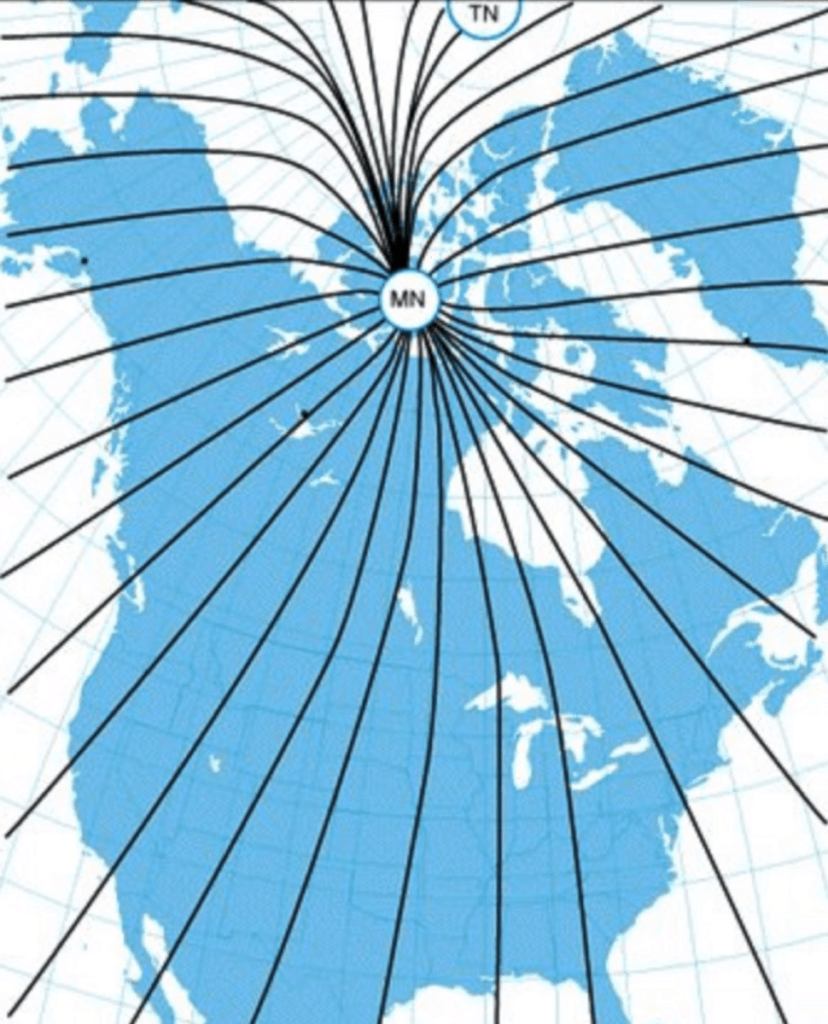
You’re flying along and ATC instructs you “turn to heading 220” and so you turn your plane until the numbers on your screen or instrument change, but what exactly are you heading towards? Why do we use two methods of showing our choice of direction and where did it all begin? Or more specifically, what’s the difference between true and magnetic heading?
Magnetic heading is your direction relative to magnetic north, read from your magnetic compass. True heading is your direction relative to true north, or the geographic north pole. The difference is due to the magnetic north pole and geographic north pole being hundreds of miles apart.
There are some interesting reasons why these poles are not in exactly the same spot, and they have some very practical implications for pilots (and even non-pilots) alike.
What’s the difference between true and magnetic north?
The simple reason that we use both true and magnetic headings, is because we have two Norths: true north and magnetic north.
According to chapter eight of the Pilots Handbook of Aeronautical Knowledge (PHAK), “The Earth rotates about its geographic axis; maps and charts are drawn using meridians of longitude that pass through the geographic poles. Directions measured from the geographic poles are called true directions.”

Simply put: true north is at the top of the giant sphere we call Earth.
The PHAK goes on to discuss magnetic north, saying “The magnetic North Pole to which the magnetic compass points is not collocated with the geographic North Pole…directions measured from the magnetic poles are called magnetic directions.”
This is where the two norths come from. One is at the tippy-top of Earth (true) and the other is hundreds of miles away (magnetic) somewhere near Northern Canada and Russia.
Calculating True vs. Magnetic Headings
To get the magnetic heading, just read the heading off your magnetic compass. Without getting into exactly how a compass works, it’s basically like this:
The compass contains certain metals (magnets) that are attracted to metals inside Earth’s crust and thus the magnetic compass orients itself to magnetic north.
To find true north, you need to know the nearby variation.
According to the PHAK, “The difference between true and magnetic directions is called variation. This same angular difference in surveying and land navigation is called declination.”
Where to Find Magnetic Variation
In order to find the variation on a VFR sectional, look for the lines of variation, or isogonic lines. On the sectional look for the dashed magenta lines with a number nearby.

These isogonic lines identify the number of degrees of variation in their area.
The line that passes near Chicago is called the agonic line. Anywhere along this line the two poles are aligned, and there is no variation.
East of this agonic line, the magnetic North Pole is to the west of the geographic North Pole and a correction must be applied to a compass indication to get a true direction.
To get the true heading, you need to first read the magnetic compass, then either add an Easterly, or subtract a Westerly, magnetic variation; based on the isogonic lines.
When converting true to magnetic heading, you’d do the opposite and subtract an Easterly, or add a Westerly, magnetic variation. This is where the saying East is least, West is best stems from.
The PHAK gives an example of variation:
Flying in the Washington, D.C., area, for example, the variation is 10° west. If a pilot wants to fly a true course of south (180°), the variation must be added to this, resulting in a magnetic course of 190° to fly. Flying in the Los Angeles, California area, the variation is 14° east. To fly a true course of 180° there, the pilot would have to subtract the variation and fly a magnetic course of 166°. The variation error does not change with the heading of the aircraft; it is the same anywhere along the isogonic line.

History in the Difference Between True and Magnetic North
True North is the North Pole. The maps used for navigating are oriented to the North Pole. A pilot can measure the direction between two points to create a “track” or “course” to fly in degrees true.
The true north pole, also known as the celestial north pole, is the point on the Earth’s surface intersecting Earth’s rotational axis on the northern hemisphere (and the axis around which all stars appear to rotate).
Prior to the introduction of the Global Positioning System (GPS), there were no perfect indicators of true north.
Two competing and often conflicting definitions of north have been used prior to the advent of GPS. Magnetic north is the direction in line with the Earth’s magnetic field, historically thought to be caused by the convective flows of liquid iron in the Earth’s outer core, which causes a compass to point toward the magnetic north pole.
An approximation of “celestial north” is in the direction of Polaris, which is a fairly bright star in the night sky and also the closest such star to Earth’s rotational axis (and thus “true north”) for about the last 1500 years. This is where the “North Star” comes from.
Why the Difference Between True and Magnetic Heading Matters
In the grand scheme of the size of Earth, one can see that true north and magnetic north are relatively close.
This is especially true from the perspective of those of us in the New World, but if you were sailing off the west coast of the British Isles, you might see up to a ten-degree difference between your compass and Polaris, and that’s significant over a distance of even a few hundred miles.
Navigators have known of this difference, known as the “magnetic declination”, for centuries, and it was a secondary driving reason for the solution to the “problem of longitude” (how to determine, quickly and accurately, your current longitude; knowing this, in addition to being a key coordinate of your position at sea, also allows you to determine the necessary amount of “declination” from magnetic north to determine true north and thus the correct magnetic heading to your intended destination).
Another example for the importance of variation:
Imagine you’re flying about 360 degrees true in relation to the North Pole, you should be flying right to the North Pole. But 360 degrees on the compass points to Magnetic North in Canada. If you haven’t applied magnetic variation, you could be flying as much as 15 degrees or so off course. This isn’t a big deal if the distance traveled is short, but increased distances can result in increased miles off course.
Additionally, it’s not only cross-country flying that is impacted by true vs. magnetic headings, but the winds themselves can be reported in true and magnetic headings depending on where and how they are reported. See our article on “Are Winds Reported in True or Magnetic Headings?”
Magnetic North Has Moved Over Time
Earth’s magnetic pole changes over time. According to surveys dating back to the past 130 years, magnetic north is moving closer and closer to true north.

One PHAK explanation said this could be due “possibly to gyroscopic stabilizations of the convective flows within earth’s liquid inner layers.
Again, for most of the U.S. the practical effects of observed shifts are minimal, but it has much more pronounced effect near the Prime Meridian which happens to be nearly perpendicular to the line between true and magnetic north.”
These changes can be noticed within a few years’ time, easily discernible in one’s lifetime. F
or pilots, keep in mind that runway numbers are the headings given in degrees magnetic, but as magnetic north is slowly moving, occasionally the runway name (ex: 35/17) will change. This is why if you have an old sectional map the numbers that you see may not agree with the runway number currently displayed.
In fact, magnetic variation is re-assessed every five years by NOAA (National Oceanic and Atmospheric Administration) when they issue a World Magnetic Model.
Why We Forget the Difference in True and Magnetic Headings
In today’s world it’s becoming easier and easier to simply input an airport into our GPS, and push “direct, enter, enter” without much thought. The worst part (for CFI’s teaching new private students) is it’s highly accurate.
GPS units have the magnetic variation included in their database and, knowing its position, will apply the appropriate value to the true track it has calculated.
A GPS will calculate a desired track between any two points and will display that line on a map or through a course deviation indicator (CDI – see our article on “CDI, HSI, OBS, and Heading Selector Explained”).
As long as you stay on the line or center the CDI you will always end up at the point on the end of the line. The heading that you need to fly to maintain that track is determined by the winds that you are flying through as you progress along the track.
So yes: a line is the fastest connection between two points, but a good pilot should work on the dead reckoning, pilotage and “old school” navigation that makes flying so fun and challenging. To do this, you’ll need to factor in the difference between true and magnetic headings (which might be a little or a lot depending on where you’re flying that day).
Conclusion
True north and magnetic north are two things that aren’t thought about with everyday flying, but they are the groundwork, the soil, the algorithm of the common GPS which helps us get from point A to point B most directly.
Flying in today’s world requires a tight-rope walk. A good pilot today should not only know the intricacies of GPS or “glass panel” flying, but should also have the necessary skills to turn off the screens and still fly the plane to safety. The ability to take in the old with the new, and use all skills necessary for a flight, is what separates the good pilots from the great pilots.
Continue to learn as much as you can and as always: fly safe, be smart and have fun.



